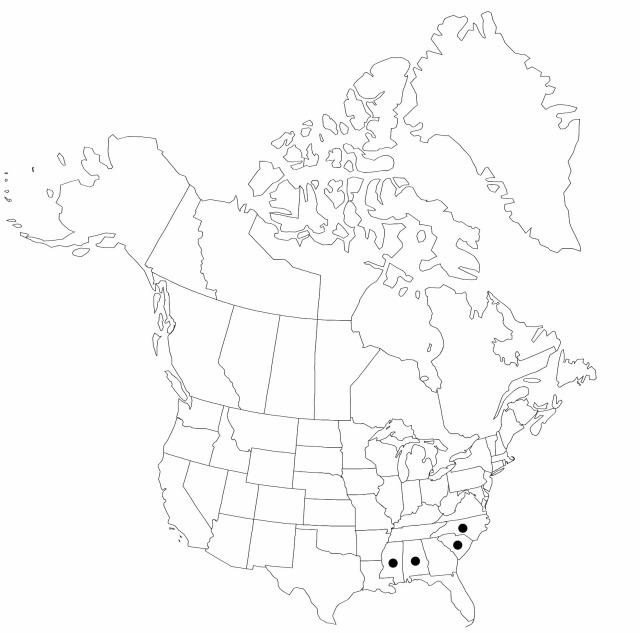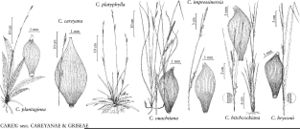Carex impressinervia
Rhodora 89: 357, figs. 1, 2. 1987.
Plants densely cespitose; rhizome internodes 1.8–2.5 mm thick. Culms yellow-brown at base, 25–85 cm. Leaves: sheaths glabrous; blades green, widest blades 2.6–4 mm wide, smooth abaxially or midrib antrorsely scaberulous. Inflorescences 0.37–0.72 of culm height; peduncles of lateral spike barely scaberulous; peduncles of terminal spikes (0.5–)1.9–6.6(–8.9) cm, usually much exceeding lateral spikes; proximal bract sheath tight, abaxially glabrous, apex slightly concave; ligules 0.4–1.8(–3.6) mm; distal bract slightly shorter than to slightly overlapping, not exceeding terminal spike. Spikes 3–5, widely separate; lateral spikes pistillate or androgynous, with 5–11 perigynia, 11–43 × 3.9–8.6 mm, ratio of spike length (in mm) to flower number = 3–6.1; terminal spikes (19–)23–31(–40) × 2.5–3(–3.3) mm. Pistillate scales 3.3–6.6 × 1.6–1.9 mm, margins whitish, entire, apex with awn 0.2–3.7 mm. Staminate scales 4.5–6.8 × 1–1.3 mm. Anthers 2.8–3.8 mm. Perigynia spirally imbricate or separate, 40–49-veined, unwrinkled, obovoid or narrowly obovoid, obtusely triangular in cross section, 4.1–5(–5.5) × 1.6–1.8 mm, 2.4–2.9(–3.4) times as long as wide, dull, base gradually tapered, apex gradually or abruptly tapered to subacute; beak absent or excurved, to 0.4(–0.7) mm. Achenes obovoid, 3.1–3.5 × 1.5–1.8 mm, tightly enveloped by perigynia; stipe bent 5–30°, 0.4–0.7 mm; beak bent 30–60°, 0.2–0.4 mm.
Phenology: Fruiting spring.
Habitat: Mesic deciduous forests, usually on gentle slopes above small streams in ravines, usually in shallow loams and sandy loams over clays
Elevation: 60–200 m
Distribution

Ala., Miss., N.C., S.C.
Discussion
Of conservation concern.
Very rare and local, Carex impressinervia is known from only fifteen populations.
Selected References
None.
